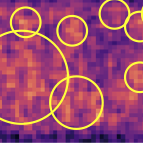Abstract
The accurate determination of the compositional fluctuations is pivotal in understanding their role in the reduction of efficiency in high indium content InxGa1-xN light-emitting diodes, the origin of which is still poorly understood. Here we have combined electron energy loss spectroscopy (EELS) imaging at sub-nanometer resolution with multiscale computational models to obtain a statistical distribution of the compositional fluctuations in InxGa1-xN quantum wells (QWs). Employing a multiscale computational model, we show the tendency of intrinsic compositional fluctuation in InxGa1-xN QWs at different Indium concentration and in the presence of strain. We have developed a systematic formalism based on the autonomous detection of compositional fluctuation in observed and simulated EELS maps. We have shown a direct comparison between the computationally predicted and experimentally observed compositional fluctuations. We have found that although a random alloy model captures the distribution of compositional fluctuations in relatively low In (~ 18%) content InxGa1-xN QWs, there exists a striking deviation from the model in higher In content (≥ 24%) QWs. Our results highlight a distinct behavior in carrier localization driven by compositional fluctuations in the low and high In-content InxGa1-xN QWs, which would ultimately affect the performance of LEDs. Furthermore, our robust computational and atomic characterization method can be widely applied to study materials in which nanoscale compositional fluctuations play a significant role on the material performance.
